fuel DODGE DART 2014 PF / 1.G Workshop Manual
[x] Cancel search | Manufacturer: DODGE, Model Year: 2014, Model line: DART, Model: DODGE DART 2014 PF / 1.GPages: 656, PDF Size: 4.73 MB
Page 566 of 656
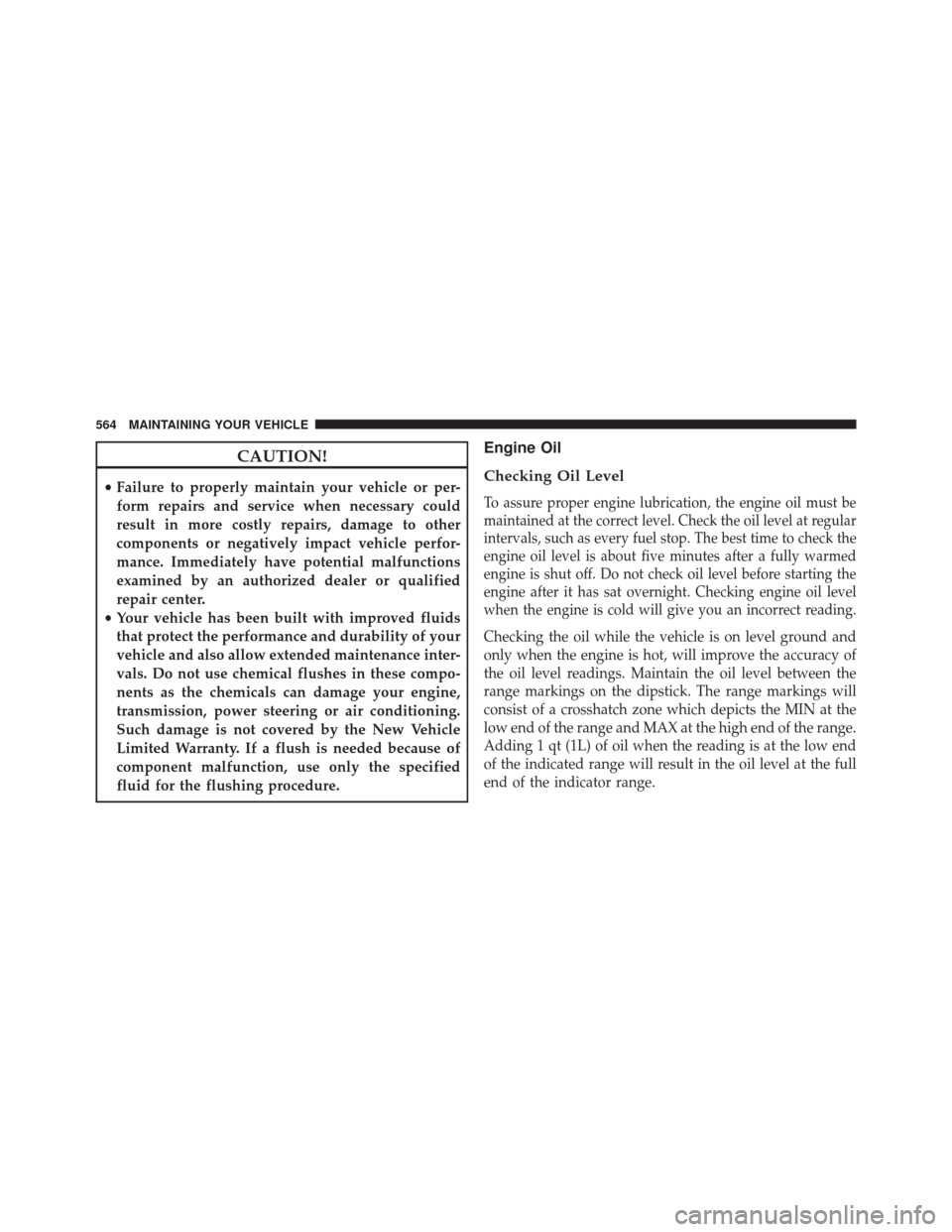
CAUTION!
•Failure to properly maintain your vehicle or per-
form repairs and service when necessary could
result in more costly repairs, damage to other
components or negatively impact vehicle perfor-
mance. Immediately have potential malfunctions
examined by an authorized dealer or qualified
repair center.
• Your vehicle has been built with improved fluids
that protect the performance and durability of your
vehicle and also allow extended maintenance inter-
vals. Do not use chemical flushes in these compo-
nents as the chemicals can damage your engine,
transmission, power steering or air conditioning.
Such damage is not covered by the New Vehicle
Limited Warranty. If a flush is needed because of
component malfunction, use only the specified
fluid for the flushing procedure.
Engine Oil
Checking Oil Level
To assure proper engine lubrication, the engine oil must be
maintained at the correct level. Check the oil level at regular
intervals, such as every fuel stop. The best time to check the
engine oil level is about five minutes after a fully warmed
engine is shut off. Do not check oil level before starting the
engine after it has sat overnight. Checking engine oil level
when the engine is cold will give you an incorrect reading.
Checking the oil while the vehicle is on level ground and
only when the engine is hot, will improve the accuracy of
the oil level readings. Maintain the oil level between the
range markings on the dipstick. The range markings will
consist of a crosshatch zone which depicts the MIN at the
low end of the range and MAX at the high end of the range.
Adding 1 qt (1L) of oil when the reading is at the low end
of the indicated range will result in the oil level at the full
end of the indicator range.
564 MAINTAINING YOUR VEHICLE
Page 568 of 656

Engine Oil Viscosity (SAE Grade) — 1.4L Turbo
Engine
MOPAR® SAE 5W-40 synthetic engine oil or equivalent
Pennzoil® or Shell Helix® is recommended for all oper-
ating temperatures. This engine oil improves low tem-
perature starting and vehicle fuel economy. Your engine
oil filler cap also states the recommended engine oil
viscosity grade for your engine.
Lubricants which do not have both the engine oil certi-
fication mark and the correct SAE viscosity grade num-
ber should not be used.
Engine Oil Viscosity (SAE Grade) — 2.0L And
2.4L Engine
MOPAR® SAE 0W-20 engine oil or equivalent Pennzoil®
or Shell Helix® is recommended for all operating tem-
peratures. This engine oil improves low temperature
starting and vehicle fuel economy. Your engine oil filler
cap also states the recommended engine oil viscosity
grade for your engine.
Lubricants which do not have both the engine oil certi-
fication mark and the correct SAE viscosity grade num-
ber should not be used.
Materials Added To Engine Oil
The manufacturer strongly recommends against the addi-
tion of any additives (other than leak detection dyes) to the
engine oil. Engine oil is an engineered product and its
performance may be impaired by supplemental additives.
566 MAINTAINING YOUR VEHICLE
Page 578 of 656
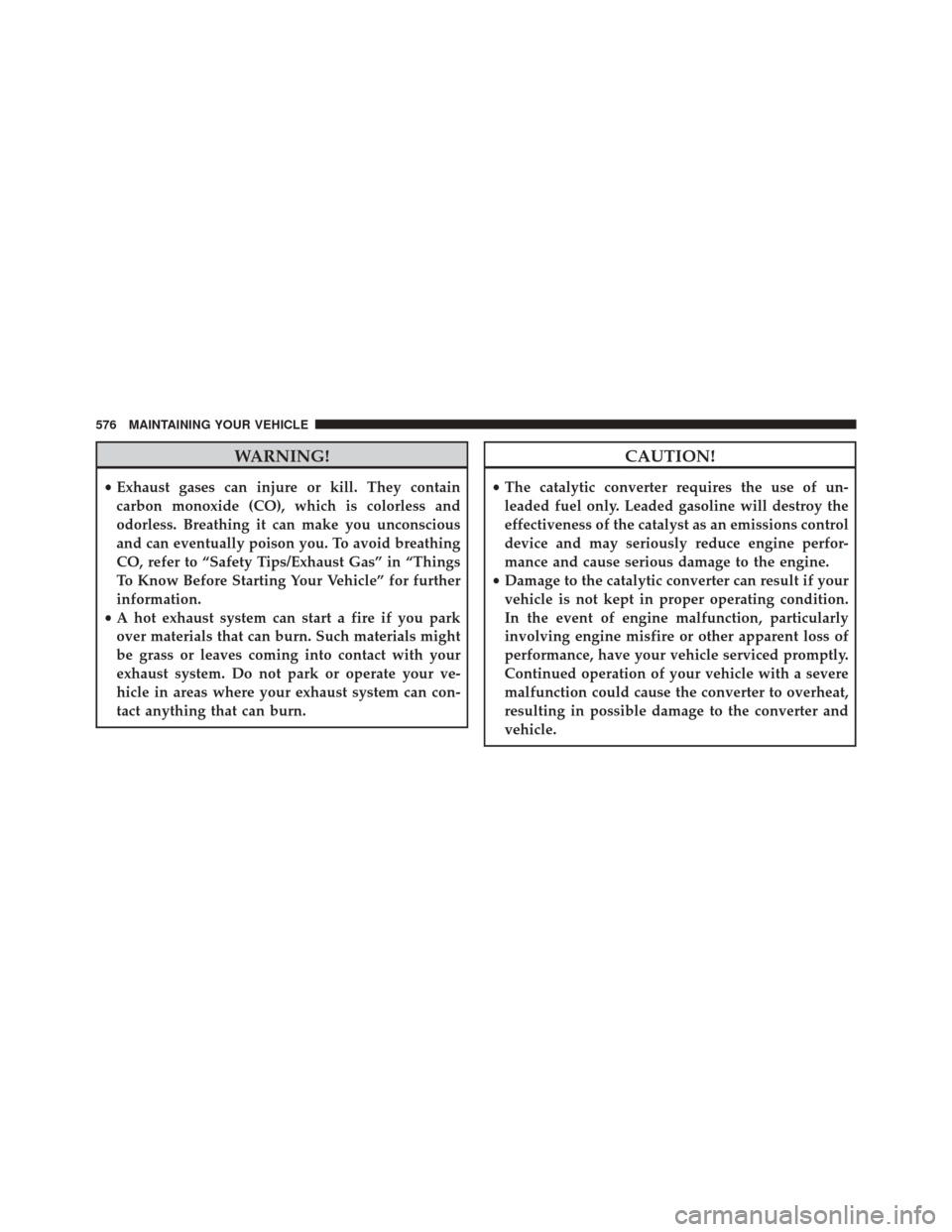
WARNING!
•Exhaust gases can injure or kill. They contain
carbon monoxide (CO), which is colorless and
odorless. Breathing it can make you unconscious
and can eventually poison you. To avoid breathing
CO, refer to “Safety Tips/Exhaust Gas” in “Things
To Know Before Starting Your Vehicle” for further
information.
• A hot exhaust system can start a fire if you park
over materials that can burn. Such materials might
be grass or leaves coming into contact with your
exhaust system. Do not park or operate your ve-
hicle in areas where your exhaust system can con-
tact anything that can burn.
CAUTION!
•The catalytic converter requires the use of un-
leaded fuel only. Leaded gasoline will destroy the
effectiveness of the catalyst as an emissions control
device and may seriously reduce engine perfor-
mance and cause serious damage to the engine.
• Damage to the catalytic converter can result if your
vehicle is not kept in proper operating condition.
In the event of engine malfunction, particularly
involving engine misfire or other apparent loss of
performance, have your vehicle serviced promptly.
Continued operation of your vehicle with a severe
malfunction could cause the converter to overheat,
resulting in possible damage to the converter and
vehicle.
576 MAINTAINING YOUR VEHICLE
Page 598 of 656
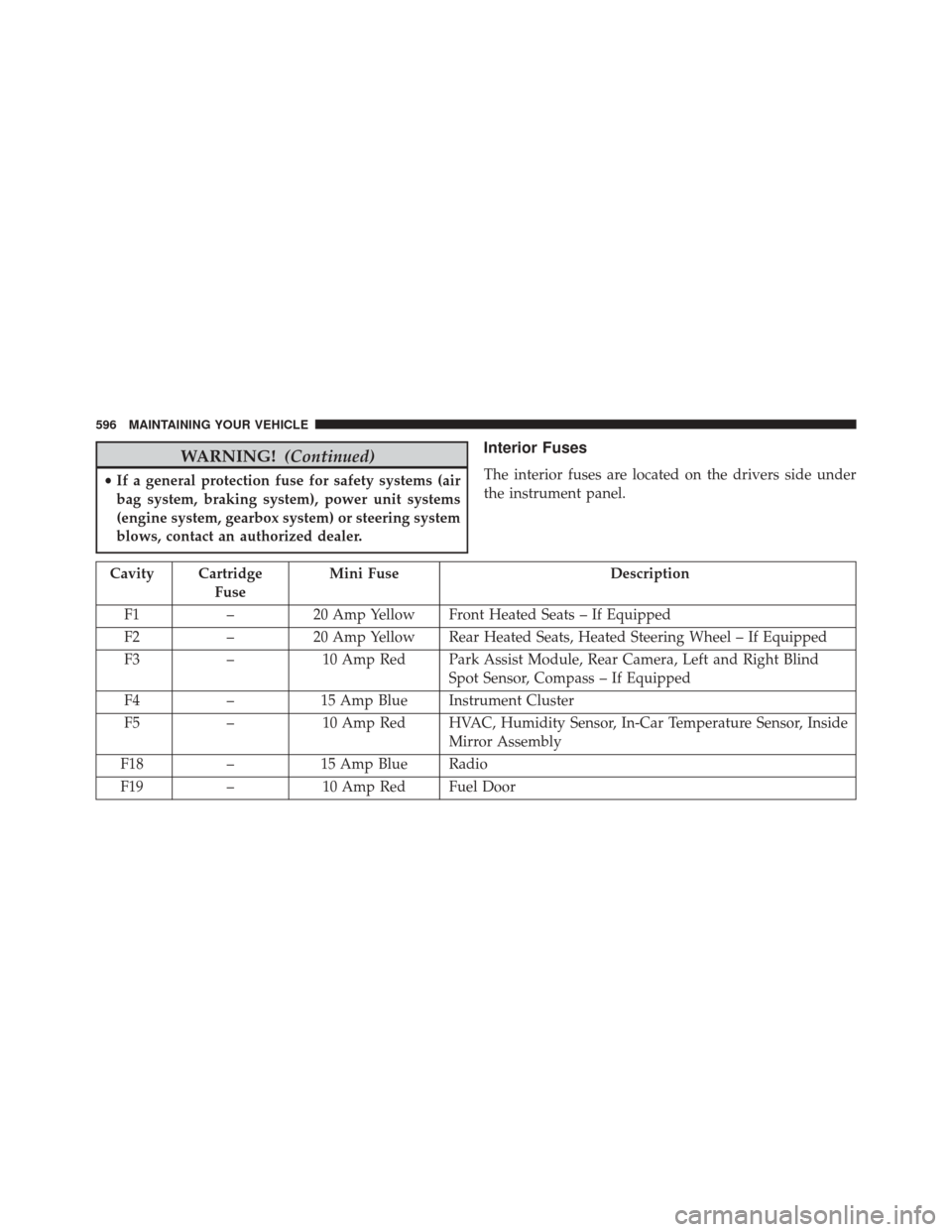
WARNING!(Continued)
•If a general protection fuse for safety systems (air
bag system, braking system), power unit systems
(engine system, gearbox system) or steering system
blows, contact an authorized dealer.
Interior Fuses
The interior fuses are located on the drivers side under
the instrument panel.
Cavity Cartridge
Fuse Mini Fuse
Description
F1 –20 Amp Yellow Front Heated Seats – If Equipped
F2 –20 Amp Yellow Rear Heated Seats, Heated Steering Wheel – If Equipped
F3 –10 Amp Red Park Assist Module, Rear Camera, Left and Right Blind
Spot Sensor, Compass – If Equipped
F4 –15 Amp Blue Instrument Cluster
F5 –10 Amp Red HVAC, Humidity Sensor, In-Car Temperature Sensor, Inside
Mirror Assembly
F18 –15 Amp Blue Radio
F19 –10 Amp Red Fuel Door
596 MAINTAINING YOUR VEHICLE
Page 601 of 656
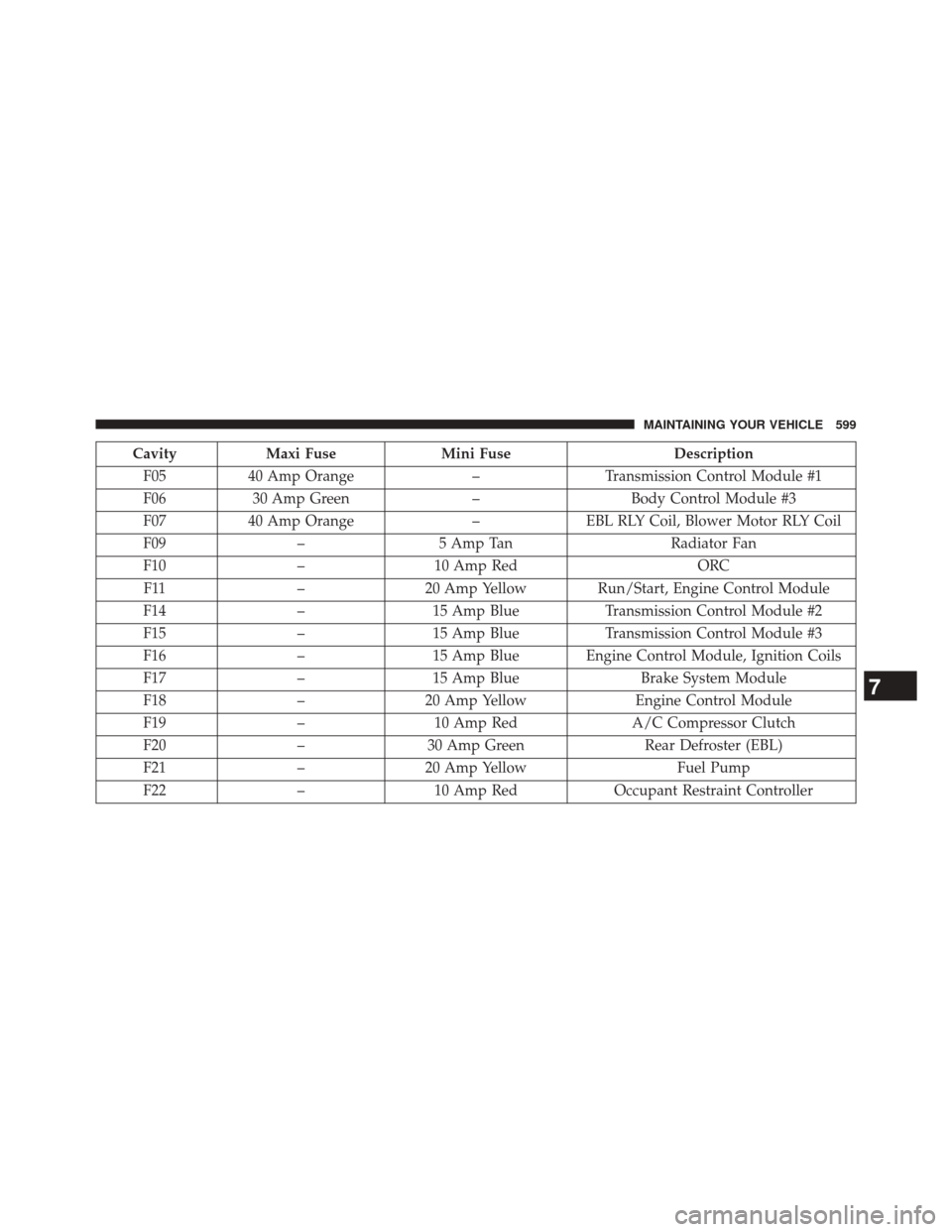
CavityMaxi Fuse Mini Fuse Description
F05 40 Amp Orange –Transmission Control Module #1
F06 30 Amp Green –Body Control Module #3
F07 40 Amp Orange –EBL RLY Coil, Blower Motor RLY Coil
F09 –5 Amp Tan Radiator Fan
F10 –10 Amp Red ORC
F11 –20 Amp Yellow Run/Start, Engine Control Module
F14 –15 Amp Blue Transmission Control Module #2
F15 –15 Amp Blue Transmission Control Module #3
F16 –15 Amp Blue Engine Control Module, Ignition Coils
F17 –15 Amp Blue Brake System Module
F18 –20 Amp Yellow Engine Control Module
F19 –10 Amp Red A/C Compressor Clutch
F20 –30 Amp Green Rear Defroster (EBL)
F21 –20 Amp Yellow Fuel Pump
F22 –10 Amp Red Occupant Restraint Controller
7
MAINTAINING YOUR VEHICLE 599
Page 602 of 656
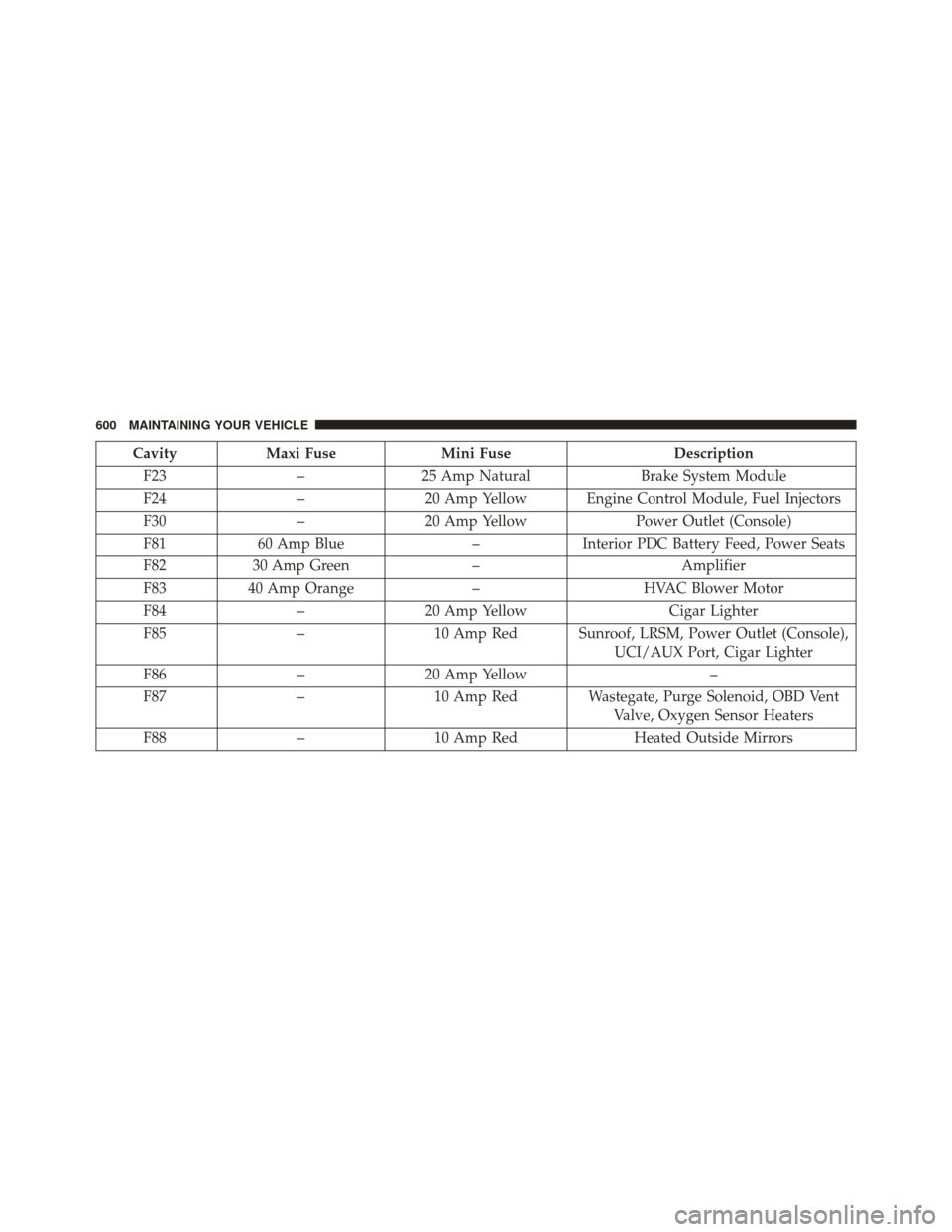
CavityMaxi Fuse Mini Fuse Description
F23 –25 Amp Natural Brake System Module
F24 –20 Amp Yellow Engine Control Module, Fuel Injectors
F30 –20 Amp Yellow Power Outlet (Console)
F81 60 Amp Blue –Interior PDC Battery Feed, Power Seats
F82 30 Amp Green –Amplifier
F83 40 Amp Orange –HVAC Blower Motor
F84 –20 Amp Yellow Cigar Lighter
F85 –10 Amp Red Sunroof, LRSM, Power Outlet (Console),
UCI/AUX Port, Cigar Lighter
F86 –20 Amp Yellow –
F87 –10 Amp Red Wastegate, Purge Solenoid, OBD Vent
Valve, Oxygen Sensor Heaters
F88 –10 Amp Red Heated Outside Mirrors
600 MAINTAINING YOUR VEHICLE
Page 610 of 656
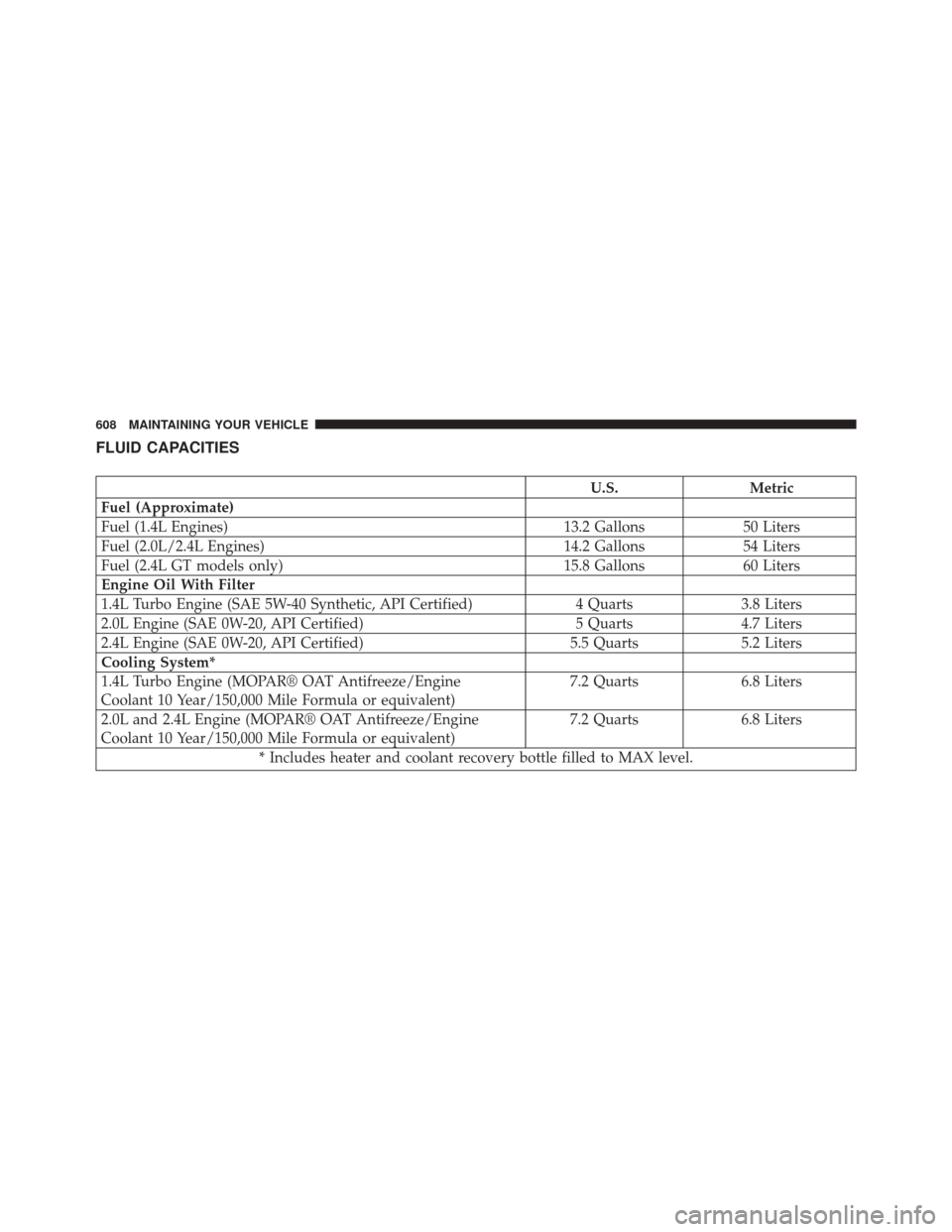
FLUID CAPACITIES
U.S.Metric
Fuel (Approximate)
Fuel (1.4L Engines) 13.2 Gallons50 Liters
Fuel (2.0L/2.4L Engines) 14.2 Gallons54 Liters
Fuel (2.4L GT models only) 15.8 Gallons60 Liters
Engine Oil With Filter
1.4L Turbo Engine (SAE 5W-40 Synthetic, API Certified) 4 Quarts3.8 Liters
2.0L Engine (SAE 0W-20, API Certified) 5 Quarts4.7 Liters
2.4L Engine (SAE 0W-20, API Certified) 5.5 Quarts5.2 Liters
Cooling System*
1.4L Turbo Engine (MOPAR® OAT Antifreeze/Engine
Coolant 10 Year/150,000 Mile Formula or equivalent) 7.2 Quarts
6.8 Liters
2.0L and 2.4L Engine (MOPAR® OAT Antifreeze/Engine
Coolant 10 Year/150,000 Mile Formula or equivalent) 7.2 Quarts
6.8 Liters
* Includes heater and coolant recovery bottle filled to MAX level.
608 MAINTAINING YOUR VEHICLE
Page 612 of 656
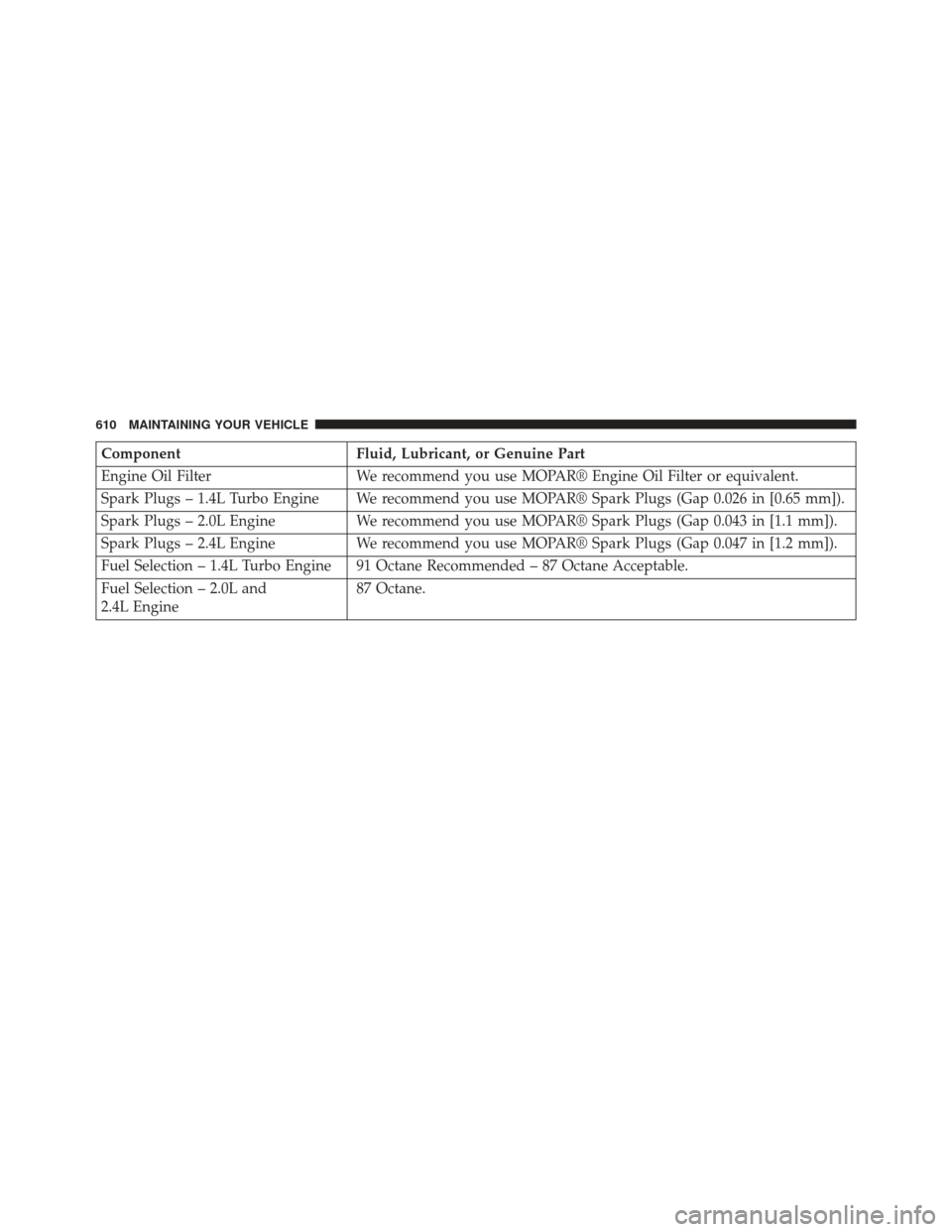
ComponentFluid, Lubricant, or Genuine Part
Engine Oil Filter We recommend you use MOPAR® Engine Oil Filter or equivalent.
Spark Plugs – 1.4L Turbo Engine We recommend you use MOPAR® Spark Plugs (Gap 0.026 in [0.65 mm]).
Spark Plugs – 2.0L Engine We recommend you use MOPAR® Spark Plugs (Gap 0.043 in [1.1 mm]).
Spark Plugs – 2.4L Engine We recommend you use MOPAR® Spark Plugs (Gap 0.047 in [1.2 mm]).
Fuel Selection – 1.4L Turbo Engine 91 Octane Recommended – 87 Octane Acceptable.
Fuel Selection – 2.0L and
2.4L Engine 87 Octane.
610 MAINTAINING YOUR VEHICLE
Page 616 of 656
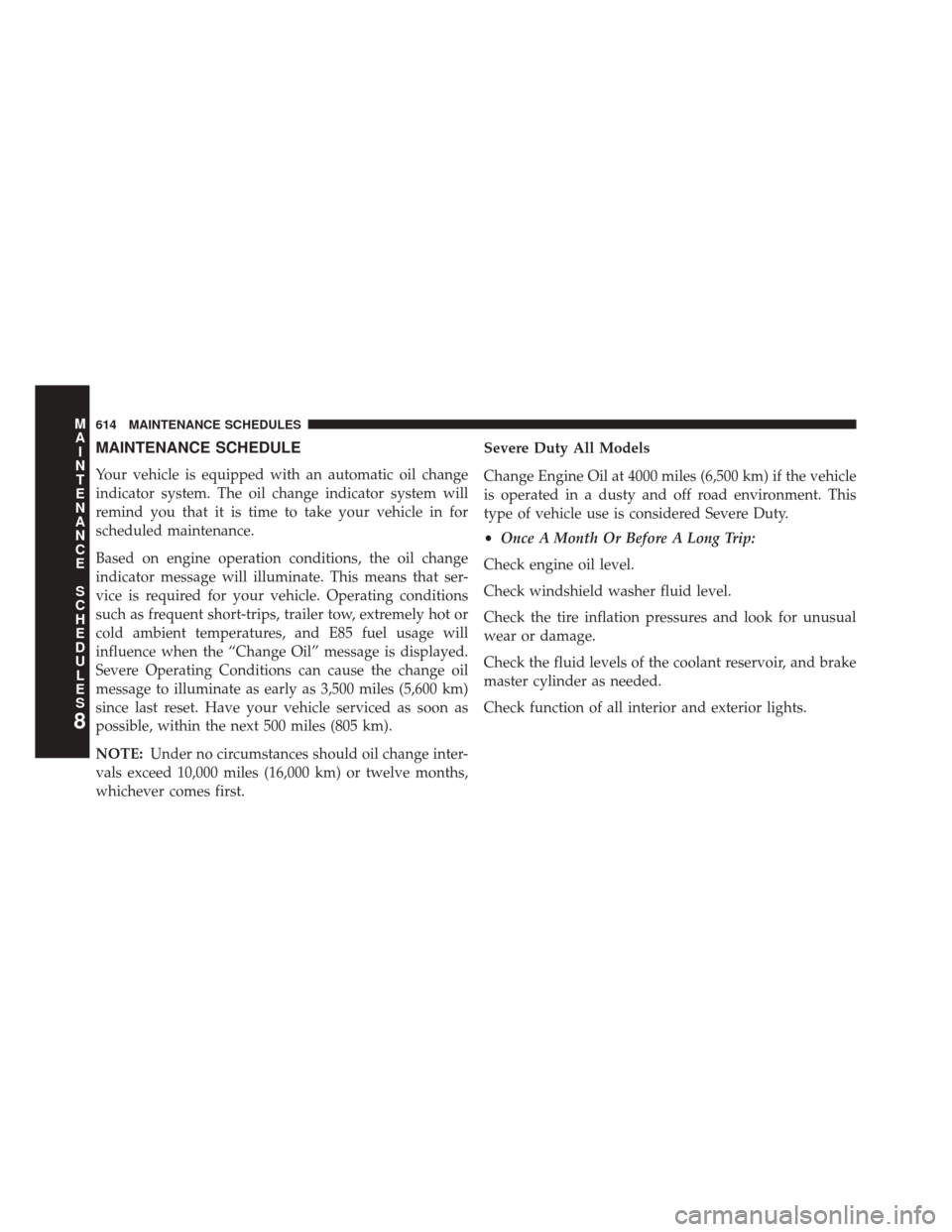
MAINTENANCE SCHEDULE
Your vehicle is equipped with an automatic oil change
indicator system. The oil change indicator system will
remind you that it is time to take your vehicle in for
scheduled maintenance.
Based on engine operation conditions, the oil change
indicator message will illuminate. This means that ser-
vice is required for your vehicle. Operating conditions
such as frequent short-trips, trailer tow, extremely hot or
cold ambient temperatures, and E85 fuel usage will
influence when the “Change Oil” message is displayed.
Severe Operating Conditions can cause the change oil
message to illuminate as early as 3,500 miles (5,600 km)
since last reset. Have your vehicle serviced as soon as
possible, within the next 500 miles (805 km).
NOTE:Under no circumstances should oil change inter-
vals exceed 10,000 miles (16,000 km) or twelve months,
whichever comes first. Severe Duty All Models
Change Engine Oil at 4000 miles (6,500 km) if the vehicle
is operated in a dusty and off road environment. This
type of vehicle use is considered Severe Duty.
•
Once A Month Or Before A Long Trip:
Check engine oil level.
Check windshield washer fluid level.
Check the tire inflation pressures and look for unusual
wear or damage.
Check the fluid levels of the coolant reservoir, and brake
master cylinder as needed.
Check function of all interior and exterior lights.
8
M A I
N T
E
N
A
N
C E
S
C
H E
D
U L
E
S614 MAINTENANCE SCHEDULES
Page 634 of 656
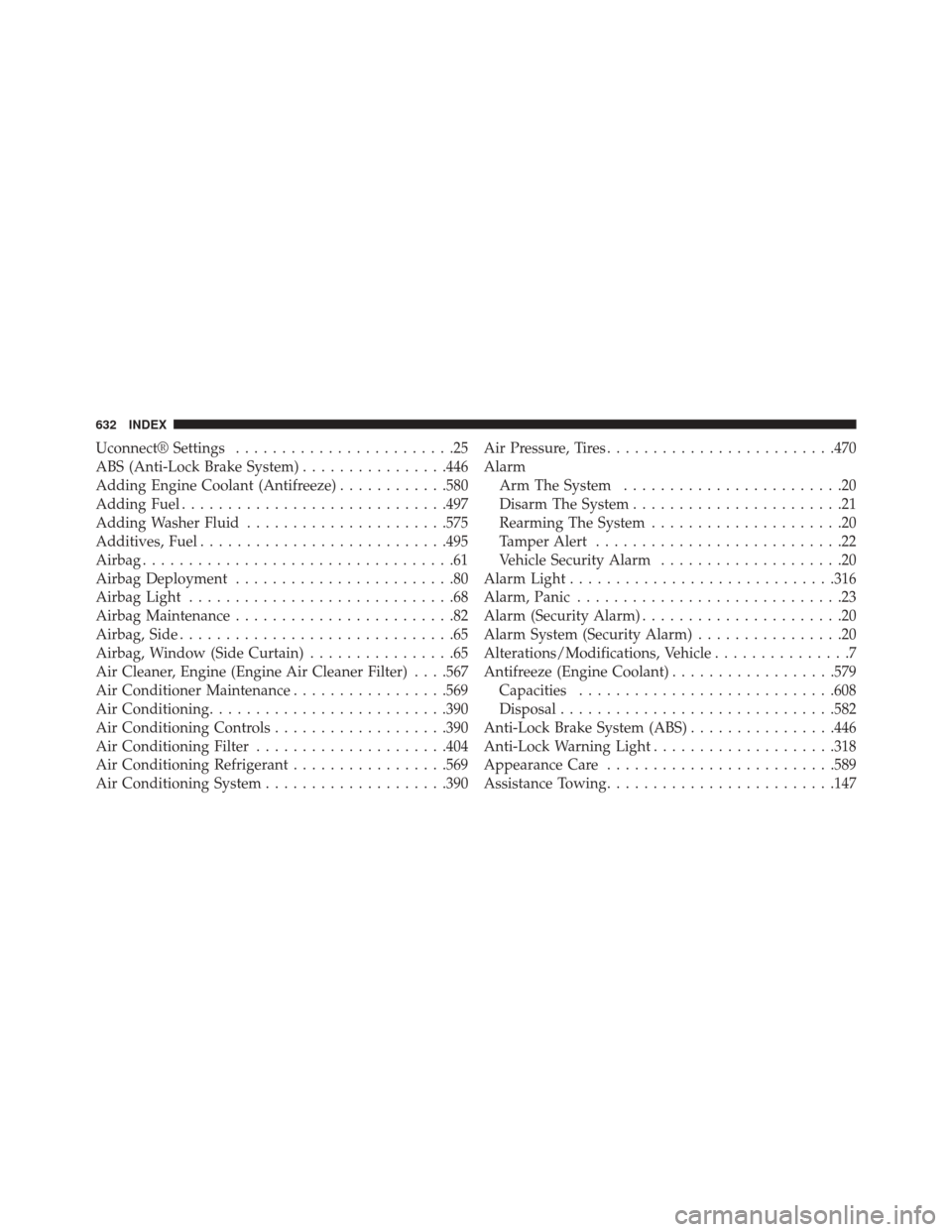
Uconnect® Settings........................25
ABS (Anti-Lock Brake System) ................446
Adding Engine Coolant (Antifreeze) ............580
Adding Fuel ............................ .497
Adding Washer Fluid ..................... .575
Additives, Fuel .......................... .495
Airbag ..................................61
Airbag Deployment ........................80
Airbag Light .............................68
Airbag Maintenance ........................82
Airbag, Side ..............................65
Airbag, Window (Side Curtain) ................65
Air Cleaner, Engine (Engine Air Cleaner Filter) . . . .567
Air Conditioner Maintenance .................569
Air Conditioning ..........................390
Air Conditioning Controls ...................390
Air Conditioning Filter .....................404
Air Conditioning Refrigerant .................569
Air Conditioning System ....................390 Air Pressure, Tires
........................ .470
Alarm Arm The System ........................20
Disarm The System .......................21
Rearming The System .....................20
Tamper Alert ...........................22
Vehicle Security Alarm ....................20
Alarm Light ............................ .316
Alarm, Panic .............................23
Alarm (Security Alarm) ......................20
Alarm System (Security Alarm) ................20
Alterations/Modifications, Vehicle ...............7
Antifreeze (Engine Coolant) ..................579
Capacities ............................608
Disposal ............................. .582
Anti-Lock Brake System (ABS) ................446
Anti-Lock Warning Light ....................318
Appearance Care ........................ .589
Assistance Towing ........................ .147
632 INDEX